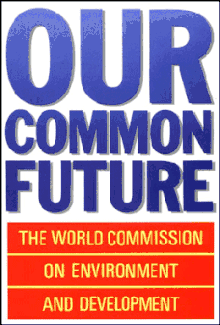Our Common Future
 | |
| Author | World Commission on Environment and Development |
|---|---|
| Subject | Sustainability |
| Publisher | Oxford University Press |
Publication date | 1987 |
| Pages | 383 |
| ISBN | 019282080X |
Our Common Future, also known as the Brundtland Report in recognition of former Norwegian Prime Minister Gro Harlem Brundtland's role as Chair of the World Commission on Environment and Development (WCED), was published in 1987 by the United Nations through the Oxford University Press.
Its targets were multilateralism and interdependence of nations in the search for a sustainable development path. The report sought to recapture the spirit of the Stockholm Conference which had introduced environmental concerns to the formal political development sphere. Our Common Future placed environmental issues firmly on the political agenda; it aimed to discuss the environment and development as one single issue.
The document was the culmination of a “900-day” international-exercise which catalogued, analysed, and synthesised: written submissions and expert testimony from “senior government representatives, scientists and experts, research institutes, industrialists, representatives of non-governmental organizations, and the general public” held at public hearings throughout the world.
Content
The Brundtland Commission's mandate was to:[1]
- “ re-examine the critical issues of environment and development and to formulate innovative, concrete, and realistic action proposals to deal with them;
- strengthen international cooperation on environment and development and to assess and propose new forms of cooperation that can break out of existing patterns and influence policies and events in the direction of needed change; and
- raise the level of understanding and commitment to action on the part of individuals, voluntary organizations, businesses, institutes, and governments” (1987: 347). “The Commission focused its attention in the areas of population, food security, the loss of species and genetic resources, energy, industry, and human settlements - realizing that all of these are connected and cannot be treated in isolation one from another”
The Brundtland Commission Report recognised that human resource development in the form of poverty reduction, gender equity, and wealth redistribution was crucial to formulating strategies for environmental conservation, and it also recognised that environmental-limits to economic growth in industrialised and industrialising societies existed. The Brundtland Report claimed that poverty reduces sustainability and accelerates environmental pressures – creating a need for the balancing between economy and ecology.[2] As such, the Report offered “[the] analysis, the broad remedies, and the recommendations for a sustainable course of development” within such societies (1987: 16). However, the Report was unable to identify the mode(s) of production that are responsible for degradation of the environment, and in the absence of analysing the principles governing market-led economic growth, the Report postulated that such growth could be reformed (and expanded); this lack of analysis resulted in an obfuscated-introduction of the term sustainable development.[3]
The publication of Our Common Future and the work of the World Commission on Environment and Development laid the groundwork for the convening of the 1992 Earth Summit and the adoption of Agenda 21, the Rio Declaration and to the establishment of the Commission on Sustainable Development.
An oft-quoted definition of sustainable development is defined in the report as:
- "development that meets the needs of the present without compromising the ability of future generations to meet their own needs."
In addition, key contributions of Our Common Future to the concept of sustainable development include the recognition that the many crises facing the planet are interlocking crises that are elements of a single crisis of the whole [4] and of the vital need for the active participation of all sectors of society in consultation and decisions relating to sustainable development.
See also
References
- ↑ World Commission on Environment and Development (1987). Our Common Future. Oxford: Oxford University Press. p. 27. ISBN 019282080X.
- ↑ Pyla, Panayiota (2012). "Beyond Smooth Talk". Design and Culture. 4 (3): 273–278.
- ↑ http://www.islandvulnerability.org/m/ahmedm.pdf
- ↑ Development, World Commission on Environment and. "Our Common Future: From One Earth to One World - A/42/427 Annex, Overview - UN Documents: Gathering a body of global agreements". www.un-documents.net.
Further reading
- Ahmed, Faiz (2008). An Examination of the Development Path Taken by Small Island Developing States (PDF). (pp. 17–26)
- Iris Borowy, Defining Sustainable Development: the World Commission on Environment and Development (Brundtland Commission), Milton Park: earthscan/Routledge, 2014
External links
| Wikisource has original text related to this article: |